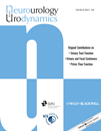Is pelvic pain associated with defecatory symptoms in women with pelvic organ prolapse?† ‡ §
Conflicts of interest: none.
Linda Brubaker led the review process.
Podium presentation at the American Urogynecologic Society 30th Annual Scientific Meeting, September 24–26, 2009 Westin Diplomat Resort, Hollywood Florida.
Abstract
Objective
To investigate the significance of pelvic pain and its association with defecatory symptoms in women with pelvic organ prolapse (POP).
Study Design
This is a cross sectional study of 248 women with stage II POP or greater. Women were stratified into “pain” and “no-pain” groups based on their response to a question on the Pelvic Floor Distress Inventory short form. Associations between patient demographics, exam findings and responses to validated questionnaires were evaluated.
Results
In women with POP, defecatory symptoms are significantly more common in women with pelvic pain including straining with bowel movement (OR 2.4, 95% CI 1.3, 4.6), sense of incomplete emptying (OR 4.4, 95% CI 2.3, 8.2), pain with bowel movement (OR 5.3, 95% CI 1.2, 23.0) and splinting with bowel movement (OR 3.8, 95% CI 2.0, 7.5).
Conclusion
In women with POP, the symptom of pelvic pain is associated with the presence of defecatory symptoms. Neurourol. Urodynam. 30:1305–1308, 2011. © 2011 Wiley-Liss, Inc.




